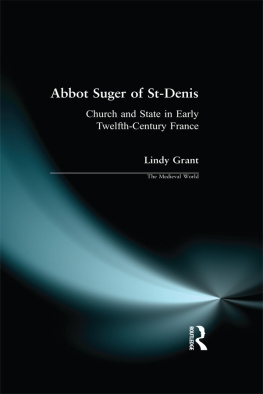ABBOT SUGER OF ST-DENIS
THE MEDIEVAL WORLD
Editor: David Bates
JUSTINIAN
John Moorhead
CHARLES THE BALD
Janet Nelson
CNUT
M. K Lawson
MEDIEVAL CANON LAW
James A. Brundage
THE FORMATION OF THE ENGLISH COMMON LAW
John Hudson
ABBOT SUGER OF ST-DENIS
Lindy Grant
WILLIAM MARSHAL
David Crouch
KING JOHN
Ralph V. Turner
PHILIP AUGUSTUS
Jim Bradbury
INNOCENT III
Jane Sayers
THE FRIARS
C. H. Lawrence
THE WESTERN MEDITERRANEAN KINGDOMS 12001500
David Abulafia
CHARLES I OF ANJOU
Jean Dunbabin
ENGLISH NOBLEWOMEN IN THE LATER MIDDLE AGES
Jennifer C. Ward
BASTARD FEUDALISM
Michael Hicks
.....
ABBOT SUGER OF ST-DENIS
Church and State in
Early Twelfth-Century France
Lindy Grant
First published 1998 by Addison Wesley Longman Limited
Published 2013 by Routledge
2 Park Square, Milton Park, Abingdon, Oxon 0X14 4RN
52 Vanderbilt Avenue, New York, NY 10017, USA
Routledge is an imprint of the Taylor & Francis Group, an informa business
Copyright 1998, Taylor & Francis.
The right of Dr Lindy Grant to be identified as author of this Work has been asserted by her in accordance with the Copyright, Designs and Patents Act 1988.
All rights reserved. No part of this book may be reprinted or reproduced or utilised in any form or by any electronic, mechanical, or other means, now known or hereafter invented, including photocopying and recording, or in any information storage or retrieval system, without permission in writing from the publishers.
Notices
Knowledge and best practice in this field are constantly changing. As new research and experience broaden our understanding, changes in research methods, professional practices, or medical treatment may become necessary.
Practitioners and researchers must always rely on their own experience and knowledge in evaluating and using any information, methods, compounds, or experiments described herein. In using such information or methods they should be mindful of their own safety and the safety of others, including parties for whom they have a professional responsibility.
To the fullest extent of the law, neither the Publisher nor the authors, contributors, or editors, assume any liability for any injury and/or damage to persons or property as a matter of products liability, negligence or otherwise, or from any use or operation of any methods, products, instructions, or ideas contained in the material herein.
ISBN 13: 978-0-582-05150-8 (pbk)
British Library Cataloguing in Publication Data
A catalogue entry for this title is available from the British Library
Library of Congress Cataloging-in-Publication Data
Grant, Lindy.
Abbot Suger of St.-Denis : church and state in early twelfth-century France / Lindy Grant.
p. cm. (The medieval world)
Includes bibliographical references and index.
ISBN 0-582-05150-9. ISBN 0-582-05154-1
1. Suger, Abbot of Saint Denis, 1081-1151. 2. FranceChurch history987-1515. 3. Civilization, Medieval12th century.
I. Title. II. Series.
BX4705.S8686G73 1998
282.092dc21
[B] 97-31323
CIP
Set by 35 in 11/12pt Baskerville
For my mother and in
memory of my father
.....
Suger, abbot of the great French abbey of Saint-Denis from 1122 to his death in 1151, has over the years acquired an historiographical reputation as one of the pivotal figures in the development both of medieval civilisation and in the making of the French state. As the builder of much of the new abbey church at Saint-Denis, he has been identified as the creator single-handedly of the Gothic style of architecture. And as the adviser to and biographer of kings Louis VI (11081137) and Louis VII (11371180), as the mastermind of the theoretical framework which had transformed the French monarchy by the time of Louis VIIs son, Philip Augustus (11801223). This reputation is based primarily on the way in which Sugers writings and the remains of his abbey church have been interpreted. Foremost among the former are the Vita Ludovici Grossi (the Life of Louis the Fat), a biography of King Louis VI, and the De Administrationen an account of his abbacy. Taken as a whole the combination of literary, architectural and decorative evidence has been used to portray Suger as one of the most original and creative figures of the Twelfth-Century Renaissance.
The central theme of Lindy Grants book is that all aspects of Sugers career, writings and ideas should be set in the contemporary context of a diverse twelfth-century world which was emerging from the traumas of Gregorian Reform and exploring new ways of expressing religious belief. This world was, however, one which was also profoundly aware of, and absorbed in, the traditions and intellectual legacy of the past. In this context Suger emerges as an extremely important, but in most respects unoriginal, figure. He was above all the abbot of a wealthy and ancient abbey which was anxious to preserve its status as the burial church of Merovingians, Carolingians and Capetians, French kings, and which was also representative of the traditions of long-established Benedictine monasticism. As a result Sugers central concern was always with his duties as abbot of Saint-Denis. He was, however, also expected to counsel the French kings and to participate in the politics of the French kingdom and of Christendom in general, tasks for which his abilities made him extremely well suited. A man of outstanding abilities, his talents were above those of the administrator, the patron and the diplomat. In contrast to what has frequently been believed, his political thought on the duties of kingship was banal. His new abbey, while drawing on an eclectic range of artistic and architectural sources, was in several respects a very conservative building and in others, original almost by accident.
This book is an exceptionally welcome addition to the Medieval World series. As a distinguished scholar fully versed in architectural history and in the interpretation of literary texts and twelfth-century society, Lindy Grant has all the necessary skills to interpret all aspects of Sugers life and achievements. A wide-ranging work of historical revisionism, her new Abbot Suger is an important individual whose career persuasively illuminates numerous facets of the dynamic social, intellectual, religious and political world of the first half of the twelfth century, while also demonstrating subtly and convincingly the complexities and challenges which this remarkably intelligent man encountered. Abbot Suger is a very important contribution to the historiography of monasticism, ecclesiastical architecture, the French kingdom and the medieval church. It lucidly and sensitively portrays the life and achievements of a churchman active in both secular and religious affairs.
.....
I must preface this book with a caveat to the art-historical emptor. It was commissioned for an historical, not an art-historical series. There is, of course, an art-historical component to the book, but it is limited. It would have been impossible in the space allowed to have done full justice to the huge literature on Sugers artistic commissions, and I have not attempted to do so. The series is not illustrated. This is perhaps an advantage, since it limits the detail in which one might discuss art-historical material. On the few occasions when specific images would support the general points I have made, I have referred readers to the relevant plates in standard and widely-available works. Fortunately, Sugers works at St-Denis are very well-illustrated in several such books. I have approached this as a book for historians, and for those art historians who might want to know how Sugers patronage fits into the broader patterns of his life and works. Nevertheless, I think that some of my comments and conclusions about what Suger did, and about what he wrote, will have implications for art-historical study, and hope that art historians who read this book will not be disappointed.













